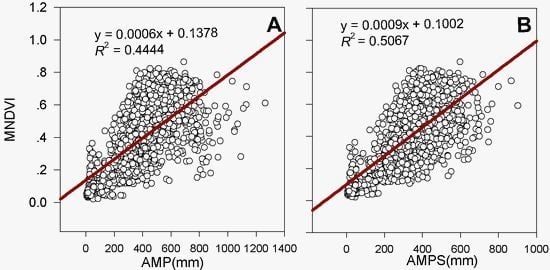On the Variation of NDVI with the Principal Climatic Elements in the Tibetan Plateau
Abstract
:1. Introduction
2. Materials and Methods
2.1. Study Area
2.2. Climatic Data
- Ȳi is the average value of a variable (one of the meteorological factors) in the Tibetan Plateau in a certain year from 1960 to 2002;
- Vj is the value of a variable in the corresponding weather station;
- X̄ is the average value of variables in all stations during this period;
- m is the total number of weather stations; and
- n is the total number of years.
- n is the annual sequence number;
- xi is the value of climatic factor in i year;
- x̄ is the annual mean value of climatic factors; and
- represents a linear ascending or descending trend of climatic factors during a given time when the value is positive or negative.
2.3. Remote Data
- NDVIij is the semi-monthly value in i year;
- MNDVIi is the annual maximum NDVI.
- n is the natural temporal sequence number 1, 2, 3,…, n year;
- MNDVIi is the value of MNDVI in i year.
- PERCENTAGE is the percentage changes, n is the annual sequence number;
- RANGE is the amplitude of the changed vegetation index from 1982 to 2006.
2.4. Analysis Tools
3. Results and Discussion
3.1. The Changed Trends of Climatic Factors on Observatory Stations
3.2. The Changed Trends of Climatic Factors in Entire Region
3.3. The Changed Trends of MNDVI on Weather Stations
3.4. The Changed Trend of MNDVI in the Entire Region
3.5. The MNDVI Response to Climatic Factors at the Observatory Stations
3.6. The MNDVI Response to Climatic Factors in the Physico-Geographical Region
3.7. The MNDVI Response to Climatic Factors in the Entire Region
4. Conclusions
Acknowledgments
References
- Wang, G.X.; Bai, W.; Li, N.; Hu, H.C. Climate changes and its impact on tundra ecosystem in Qinghai-Tibet Plateau, China. Clim. Change 2011, 106, 463–482. [Google Scholar]
- Yu, H.Y.; Luedeling, E.; Xu, J.C. Winter and spring warming result in delayed spring phenology on the Tibetan Plateau. Proc. Natl. Acad. Sci. USA 2010, 107, 22151–22156. [Google Scholar]
- Wang, G.X.; Cheng, G.D. Eco-environmental changes and causative analysis in the source regions of the Yangtze and Yellow Rivers, China. Environmentalist 2000, 20, 221–232. [Google Scholar]
- Fan, J.W.; Shao, Q.Q.; Liu, J.Y.; Wang, J.B.; Harris, W.; Chen, Z.Q.; Zhong, H.P.; Xu, X.L.; Liu, G.R. Assessment of effects of climate change and grazing activity on grassland yield in the Three Rivers Headwaters Region of Qinghai–Tibet Plateau, China. Environ. Monit. Assess 2010, 170, 571–584. [Google Scholar]
- Gurgel, H.C.; Ferreira, N.J. Annual and interannual variability of NDVI in Brazil and its connections with climate. Int. J. Remote Sens 2003, 24, 3595–3609. [Google Scholar]
- Scharlemann, J.P.W.; Benz, D.; Hay, S.I.; Purse, B.V.; Tatem, A.J. Global data for ecology and epidemiology: A novel algorithm for temporal fourier processing MODIS data. PLoS ONE 2008, 3. [Google Scholar] [CrossRef]
- Wang, J.; Meng, J.J.; Cai, Y.L. Assessing vegetation dynamics impacted by climate change in the southwestern karst region of China with AVHRR NDVI and AVHRR NPP time-series. Environ. Geol 2008, 54, 1185–1195. [Google Scholar]
- Pettorelli, N.; Vik, J.O.; Mysterud, A.; Gaillard, J.M.; Tucker, C.J.; Stenseth, N.C. Using the satellite-derived NDVI to assess ecological responses to environmental change. Trends Ecol. Evol 2005, 20, 503–510. [Google Scholar]
- Milich, L.; Weiss, E. GAC NDVI images: Relationship to rainfall and potential evaporation in the grazing lands of the Gourma (northern Sahel) and in the croplands of the Niger-Nigeria border (southern Sahel). Int. J. Remote Sens 2000, 21, 261–280. [Google Scholar]
- Gao, Q.Z.; Wan, Y.F.; Xu, H.M.; Li, Y.; Jiangcun, W.Z.; Borjigid, A. Alpine grassland degradation index and its response to recent climate variability in Northern Tibet, China. Quat. Int 2010, 226, 143–150. [Google Scholar]
- Chu, D.; Lu, L.X.; Zhang, T.G. Sensitivity of Normalized Difference Vegetation Index (NDVI) to seasonal and inter-annual climate conditions in the Lhasa area, Tibetan Plateau, China. Arct. Antarct. Alp. Res 2007, 39, 635–641. [Google Scholar]
- Piao, S.L.; Fang, J.Y.; Liu, H.; Zhu, B. NDVI-indicated decline in desertification in China in the past two decades. Geophys. Res. Lett 2005, 32, L06402. [Google Scholar]
- Wang, X.D.; Li, M.H.; Liu, S.Z.; Liu, G.C. Fractal characteristics of soils under different land-use patterns in the arid and semiarid regions of the Tibetan Plateau, China. Geoderma 2006, 134, 56–61. [Google Scholar]
- Sun, H.L. The National Physical Atlas of China (in Chinese); Cartographic Publishing House: Beijing, China, 1999. [Google Scholar]
- Zhao, J. Physical Geography of China (in Chinese); Higher Education Press: Beijing, China, 1998. [Google Scholar]
- China Meteorological Data Sharing Service. Available online: http://cdc.cma.gov.cn/ (accessed on 11 May 2012).
- Environment and Ecological Science Data Center for West China. Available online: http://westdc.westgis.ac.cn/ (accessed on 21 May 2012).
- Tucker, C.J.; Pinzon, J.E.; Brown, M.E. Global Inventory Modeling and Mapping Studies; NA94apr15b.n11-VIg, 2.0, Global Land Cover Facility (04/15/1994); University of Maryland: College Park, MD, USA, 2004. [Google Scholar]
- Holben, B.N. Characteristics of maximum value composite images from temporal AVHRR dada. Int. J. Remote Sens 1986, 7, 1417–1434. [Google Scholar]
- Ma, M.G.; Dong, L.X.; Wang, X.M. Study on the dynamically monitoring and simulating the vegetation cover in Northwest China in the past 21 years. J. Glaciol. Geocryol 2003, 25, 232–236. [Google Scholar]
- Song, Y.; Ma, M.G. Study on the vegetation cover change in Northwest China based on SPOT VEGETATION data. J. Desert Res 2007, 27, 89–93. [Google Scholar]
- Yan, F.L.; Li, Z.; Shao, Y.; Lu, H.F.; Fan, X.T.; Ren, X. Monitoring of changes in land vegetation covers using NOAA / AVHRR NDVI datasets. J. Lanzhou Univ. (Nat. Sci.) 2003, 39, 90–94. [Google Scholar]
- Zhang, G.L.; Ouyang, H.; Zhang, X.Z.; Zhou, C.P.; Xu, X.L. Vegetation change and its responses to climatic variation based on eco-geographical regions of Tibetan Plateau. Geogr. Res 2010, 29, 2010–2016. [Google Scholar]
- Wang, B.L.; French, H.M. Climate controls and high-altitude permafrost, Qinghai-Xizang (Tibet) Plateau, China. Permafrost Periglac 1994, 5, 87–100. [Google Scholar]
- Zhao, L.; Ping, C.L.; Yang, D.Q.; Cheng, G.D.; Ding, Y.L.; Liu, S.Y. Changes of climate and seasonally frozen ground over the past 30 years in Qinghai–Xizang (Tibetan) Plateau, China. Glob. Planet. Change 2004, 43, 19–31. [Google Scholar]
- Tett, S.F.B.; Stott, P.A.; Allen, M.R. Causes of twentieth-century temperature change near the earth’s surface. Nature 1999, 399, 569–572. [Google Scholar]
- Zhang, J.H.; Yao, F.M.; Zheng, L.Y.; Yang, L.M. Evaluation of grassland dynamics in the Northern-Tibet Plateau of China using remote sensing and climate data. Sensors 2007, 7, 3312–3328. [Google Scholar]
- Yang, Y.H.; Piao, S.L. Variations in grassland vegetation cover in relation to climatic factors on the Tibetan Plateau. J. Plant Ecol 2006, 30, 1–8. [Google Scholar]
- Xu, X.K.; Chen, H.; Klevy, J. Spatiotemporal vegetation cover variations in the Qinghai-Tibet Plateau under global climate change. Chin. Sci. Bull 2008, 53, 915–922. [Google Scholar]
- Li, L.; Yang, S.; Wang, Z.Y.; Zhu, X.D.; Tang, H.Y. Evidence of warming and wetting climate over the Qinghai-Tibet Plateau. Arct. Antarct. Alp. Res 2010, 42, 449–457. [Google Scholar]
- Peng, J.F.; Gou, X.H.; Chen, F.H.; Fang, K.Y. Climate–growth relationships of Qilian juniper Sabina przewalskii in the Anyemaqen mountains, Tibet. Clim. Res 2010, 41, 31–40. [Google Scholar]
- Ding, M.J.; Zhang, Y.L.; Liu, L.S.; Zhang, W.; Wang, Z.F.; Bai, W.Q. The relationship between NDVI and precipitation on the Tibetan Plateau. J. Geogr. Sci 2007, 17, 259–268. [Google Scholar]
- Zheng, D. The system of physico-geographical regions of the Qinghai-Xizang (Tibet) Plateau. Sci. China D 1996, 39, 410–417. [Google Scholar]
- Dai, S.P.; Zhang, B.; Wang, Q.; Ma, Z.H.; Zou, Y.; Zhang, Y.N. Variation in grassland vegetation NDVI and its ten-day response to temperature and precipitation in the Qilian Mountains. Resour. Sci 2010, 32, 1769–1776. [Google Scholar]
- Chen, Q.; Zhou, Q.; Zhang, H.F.; Liu, F.G. Spatial disparity of NDVI response in vegetation growing season to climate change in the Three-River Headwaters region. Ecol. Environ. Sci 2010, 19, 1284–1289. [Google Scholar]
- Zhu, Y.; Peng, G.X.; Wang, Z.; Wang, J.S.; Li, D. The trend of NDVI during the past 30 years in Linzhi Area, Tibet Autonomous Region. J. Northwest For. Univ 2011, 26, 69–74. [Google Scholar]
- Potter, C.S.; Brooks, V. Global analysis of empirical relations between annual climate and seasonality of NDVI. Int. J. Remote Sens 1998, 19, 2921–2948. [Google Scholar]
- Yu, S.M.; Liu, J.S.; Yuan, J.G. Vegetation change of Yamzho Yumco Basin in Southern Tibet based on SPOT-VGT NDVI. Spectrosc. Spect. Anal 2010, 30, 1570–1574. [Google Scholar]
- Hu, Z.M.; Yu, G.R.; Fan, J.W.; Zhong, H.P.; Wang, S.Q.; Li, S.G. Precipitation-use efficiency along a 4,500-km grassland transect. Global Ecol. Biogeogr 2010, 19, 842–851. [Google Scholar]
- Huxman, T.E.; Smith, M.D.; Fay, P.A.; Knapp, A.K.; Shaw, M.R.; Loik, M.E.; Smith, S.D.; Tissue, D.T.; Zak, J.C.; Weltzin, J.F.; et al. Convergence across biomes to a common rain-use efficiency. Nature 2004, 429, 651–654. [Google Scholar]
- O’Connor, T.G.; Haines, L.M.; Snyman, H.A. Influence of precipitation and species composition on phytomass of a semi-arid African grassland. J. Ecol 2001, 89, 850–860. [Google Scholar]
- Epstein, H.E.; Lauenroth, W.K.; Burke, I.C. Effect of temperature and soil texture on ANPP in the US Great Plains. Ecology 1997, 78, 2628–2631. [Google Scholar]
- Xu, B.C.; Gichuki, P.; Shan, L.; Li, F.M. Aboveground biomass production and soil water dynamics of fourleguminous forages in semiarid region, Northwest China. S. Afr. J. Bot 2006, 72, 507–516. [Google Scholar]
- Bai, Y.F.; Li, L.H.; Wang, Q.B.; Zhang, L.X.; Zhang, Y.; Chen, Z.Z. Changes in plant species diversity and productivity along gradients of precipitation in the Xilin river basin, Inner Mongolia. Acta Phytoecologica Sin 2000, 24, 667–673. [Google Scholar]
- Yang, Y.H.; Fang, J.Y.; Pan, Y.D. Aboveground biomass in Tibetan grasslands. J. Arid Environ 2009, 73, 91–95. [Google Scholar]
- Mao, F.; Lu, Z.G.; Zhang, J.H.; Hou, Y.Y. Relations between AVHRR NDVI and climate factors in Northern Tibet in recent 10 years. Acta Ecol. Sin 2007, 27, 3198–3205. [Google Scholar]
- Cui, L.L.; Shi, J. Temporal and spatial response of vegetation NDVI to temperature and precipitation in eastern China. J. Geogr. Sci 2010, 20, 163–176. [Google Scholar]
- Zhang, W.J.; Gao, Z.Q. Spatial variation of water/ thermal elements and NDVI with altitudes in central and eastern Tibetan Plateau. Geogr. Res 2006, 25, 878–886. [Google Scholar]
- Sun, J.; Cheng, G.W.; Li, W.P. Meta-analysis of relationships between environmental factors and aboveground biomass in the alpine grassland on the Tibetan Plateau. Biogeosciences 2013, 10, 1707–1715. [Google Scholar]

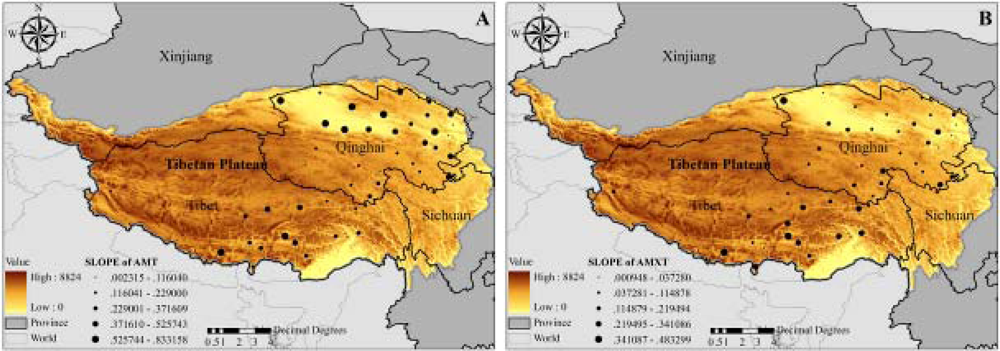

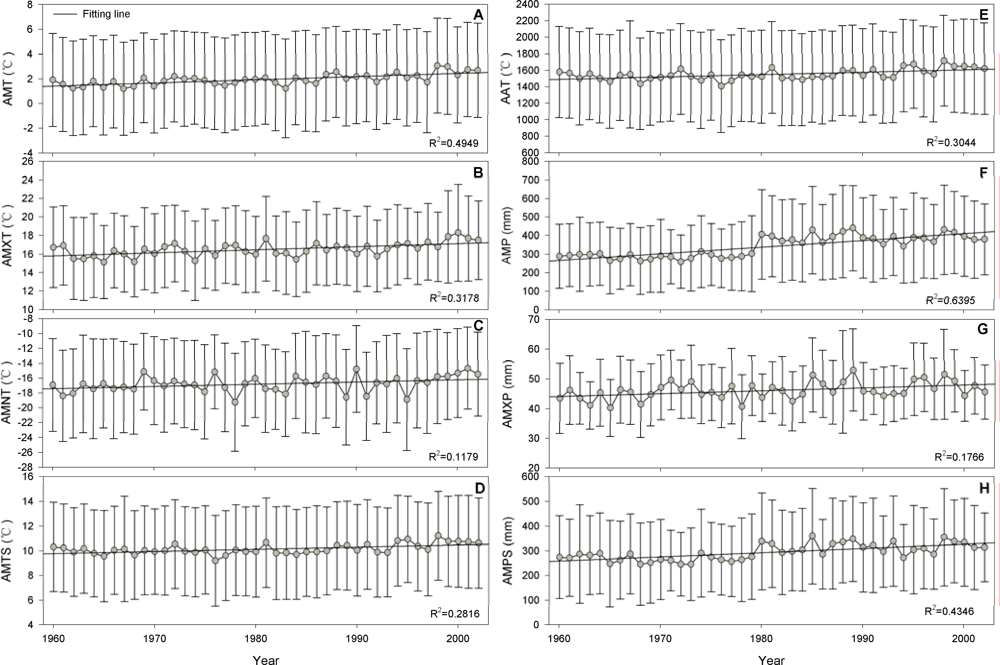
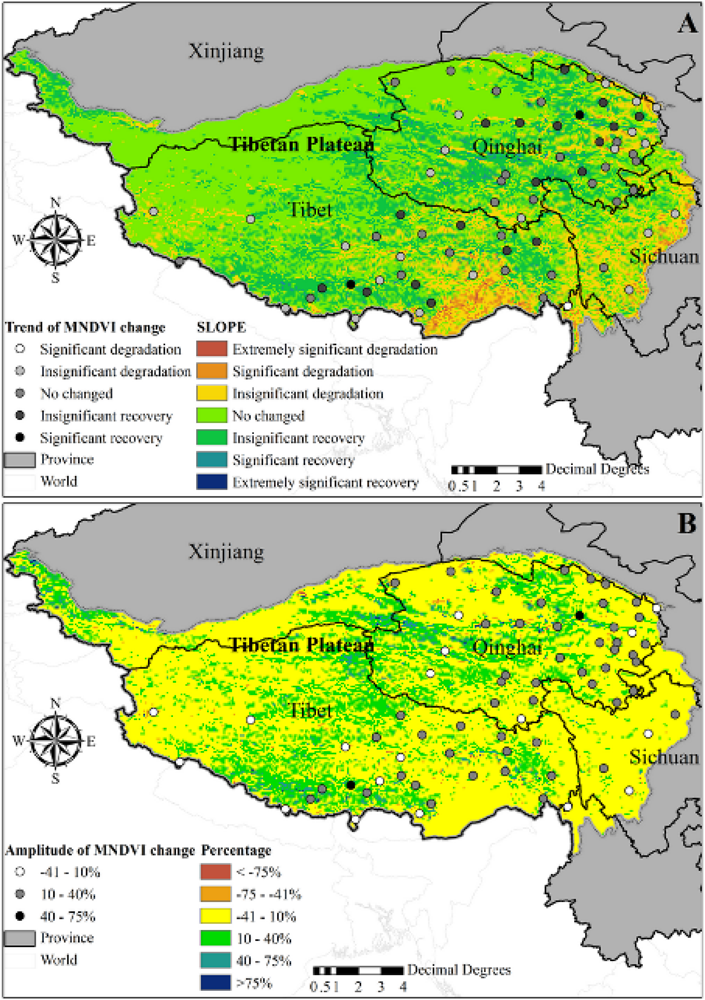

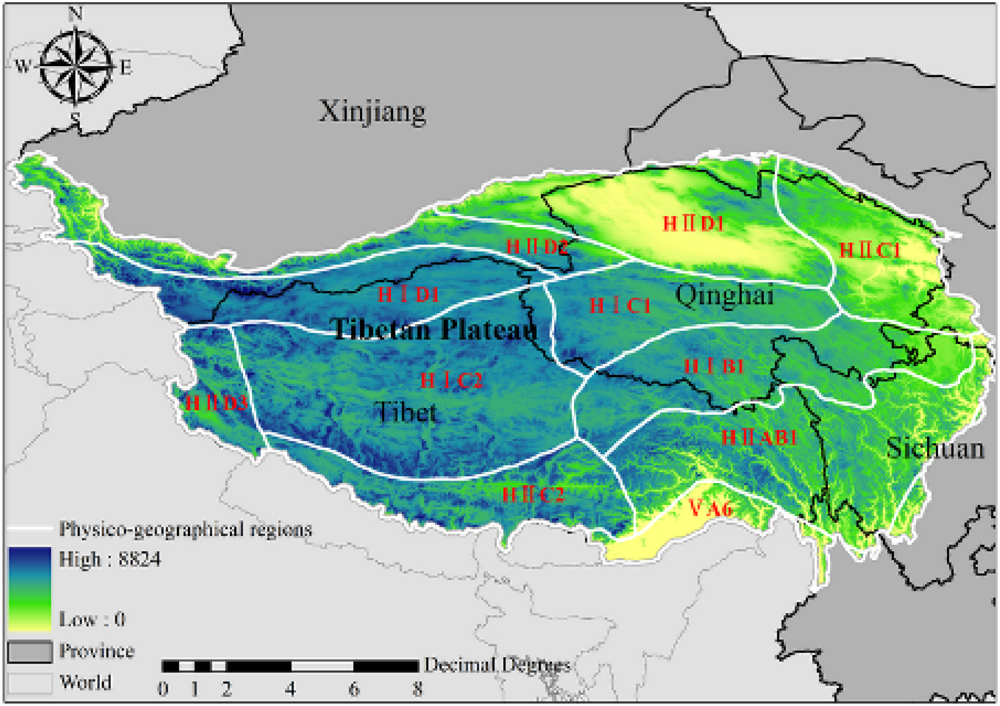

| Items | Abbreviation | In Detail |
|---|---|---|
| Category | AMT | Annual mean temperature |
| AMXT | Annual maximum temperature | |
| AMNT | Annual minimum temperature | |
| AMTS | Annual mean temperature during growing season | |
| AAT | Annual accumulated temperature | |
| AMP | Annual mean precipitation | |
| AMXP | Annual maximum precipitation | |
| AMPS | Annual mean precipitation during growing season |
| Items | The Trend of MNDVI Change | Status |
|---|---|---|
| Category | Slope ≤ −0.0091 | Extremely significant degradation |
| −0.0091 ≤ Slope ≤ −0.0046 | Significant degradation | |
| −0.0045 ≤ Slope ≤ −0.0010 | Insignificant degradation | |
| −0.0009 ≤ Slope ≤ 0.0009 | No changed | |
| 0.0010 ≤ Slope ≤ 0.0045 | Insignificant recovery | |
| 0.0046 ≤ Slope ≤ 0.0090 | Significant recovery | |
| Slope ≥ 0.0090 | Extremely significant recovery |
| Code | Physico-Geographical Region | AMT | AMXT | AMNT | AMTS | AAT | AMP | AMXP | AMPS |
|---|---|---|---|---|---|---|---|---|---|
| HID1 | North Slope of Kunlun Mountain desert region | ★ | ★ | ★ | ★ | ★ | ★ | ★ | ★ |
| HIID2 | Kunlun alpine desert region | ★ | ★ | ★ | ★ | ★ | ★ | ★ | ★ |
| HIID1 | Qaidam mountain desert region | 0.3399 | 0.0044 | 0.1868 | 0.0836 | 0.0834 | 0.5415 | 0.428 | 0.5445 |
| HIID3 | Ali desert and semi-desert region | 0.4288 | 0.1698 | 0.2234 | 0.1586 | 0.1579 | 0.3691 | 0.2324 | 0.0539 |
| HIC2 | Changtang alpine steppe region | 0.0771 | 0.4628 | 0.0744 | 0.5047 | 0.5057 | 0.3451 | 0.0607 | 0.345 |
| HIC1 | South Qinghai alpine meadow steppe region | 0.1231 | 0.0476 | 0.0127 | 0.0786 | 0.0789 | 0.1542 | 0.0053 | 0.0906 |
| HIIC1 | East Qinghai and Qilian mountain steppe region | 0.1244 | 0.2219 | 0.1154 | 0.1713 | 0.1715 | 0.2229 | 0.0142 | 0.1911 |
| HIB1 | Golog-Nagchu alpine scrub meadow region | 0.0009 | 0.0051 | 0.0034 | 0.0091 | 0.0091 | 0.0662 | 0.0046 | 0.036 |
| HIIC2 | South Tibet mountain shrub steppe region | 0.0019 | 0.0049 | 0.1677 | 0.1308 | 0.1308 | 0.2303 | 0.0217 | 0.187 |
| HIIAB1 | West Sichuan and East Tibet coniferous forest mountain region | 0.0009 | 0.0000 | 0.0068 | 0.0018 | 0.002 | 0.0011 | 0.0056 | 0.0244 |
| VA6 | South slope of the eastern Himalayas evergreen broad-leafed forest region | ★ | ★ | ★ | ★ | ★ | ★ | ★ | ★ |
Share and Cite
Sun, J.; Cheng, G.; Li, W.; Sha, Y.; Yang, Y. On the Variation of NDVI with the Principal Climatic Elements in the Tibetan Plateau. Remote Sens. 2013, 5, 1894-1911. https://doi.org/10.3390/rs5041894
Sun J, Cheng G, Li W, Sha Y, Yang Y. On the Variation of NDVI with the Principal Climatic Elements in the Tibetan Plateau. Remote Sensing. 2013; 5(4):1894-1911. https://doi.org/10.3390/rs5041894
Chicago/Turabian StyleSun, Jian, Genwei Cheng, Weipeng Li, Yukun Sha, and Yunchuan Yang. 2013. "On the Variation of NDVI with the Principal Climatic Elements in the Tibetan Plateau" Remote Sensing 5, no. 4: 1894-1911. https://doi.org/10.3390/rs5041894



